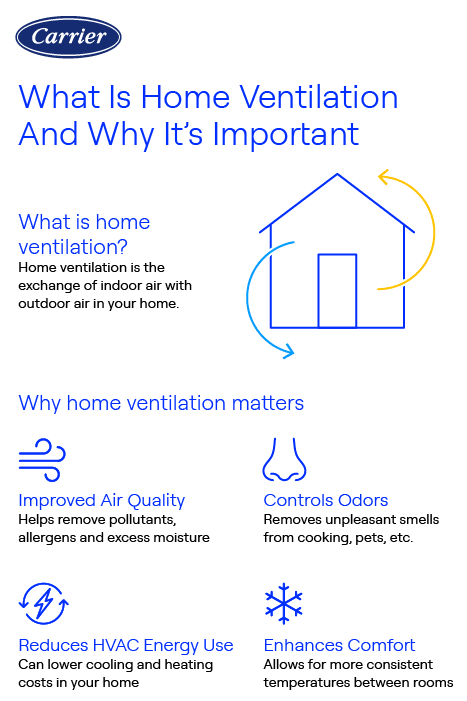What Is Home Ventilation?
By Travis Baugh
This article delves into the importance of home ventilation, signs indicating poor ventilation, methods to improve ventilation, and its contribution to a healthy indoor environment. Carrier is dedicated to offering effective home ventilation solutions tailored to your needs.

Why is Home Ventilation Important?
The Benefits of Proper Home Ventilation
- Improved Air Quality: Good ventilation removes stale air, odors, and potentially harmful pollutants from your home, allowing fresh outdoor air to circulate and reducing indoor air pollutants. Understand stale air and how to get rid of it.
- Health and Well-being: Poor ventilation can significantly impact your health. Without proper airflow, allergens, dust, and other irritants can accumulate, leading to respiratory issues, allergies, and asthma. Adequate ventilation minimizes these risks and promotes a healthier indoor environment.
How Poor Ventilation Can Affect Your Health and Well-being
- Increased Indoor Air Pollutants: Without proper ventilation, indoor air pollutants such as volatile organic compounds (VOCs), formaldehyde, and carbon monoxide can accumulate, causing headaches, fatigue, and severe respiratory issues.

Signs of Poor Home Air Ventilation
- Stale or stuffy air: If you frequently notice stagnant or musty odors in your home, it could be a sign of poor ventilation. Insufficient airflow can cause the air to become trapped, leading to unpleasant smells.
- Excessive humidity: High humidity levels can result from inadequate ventilation, especially in areas like bathrooms and kitchens. If you notice condensation on windows, peeling wallpaper, or damp spots on walls, it may indicate a ventilation problem.
- Allergies and respiratory problems: Inadequate ventilation can lead to an accumulation of dust, allergens, and pollutants, triggering allergies, asthma, and other respiratory issues. Addressing ventilation problems is essential.
- Poor indoor air quality: If you constantly experience symptoms like headaches, dizziness, or fatigue when indoors, it could be due to poor air quality caused by inadequate ventilation. Fresh air circulation is vital for removing harmful pollutants and improving overall well-being.
Improving Home Ventilation
Understanding HVAC Ventilation
Factors to Consider in HVAC Ventilation
Talk to a Carrier dealer about HVAC Ventilation Solutions

Frequently Asked Questions About Home Ventilation
Signs of poor ventilation in a house include persistent condensation on windows,, musty odors, and a feeling of stuffiness. Health symptoms such as frequent headaches, allergies, or respiratory issues among occupants can also indicate inadequate air exchange. High humidity levels and visible dampness are additional indicators. If you notice these issues, it's likely that your home needs improved ventilation.
Ventilation in an HVAC system refers to the process of exchanging indoor air with outdoor air to maintain indoor air quality. It involves removing stale air, odors, and pollutants while bringing in fresh air. Ventilation helps control humidity, reduce indoor contaminants, and maintain a comfortable environment.

